The Differences Between Dyed, Metalized, and Ceramic Window Tint Explained
Before diving into the specifics of each type, it's essential to understand the general purpose and benefits of window tints. Car window tinting involves applying a thin film to the interior side of a vehicle's windows. This film can vary in material and properties, influencing its effectiveness and suitability for different needs. The primary aim of window tinting is to enhance the vehicle's aesthetic while providing functional benefits such as UV protection and heat reduction.
Window tints also contribute to energy efficiency by reducing the need for air conditioning, which can save fuel and reduce emissions. Moreover, they can add an extra layer of safety by holding shattered glass together in the event of an accident. The choice of window tint can significantly impact its performance, durability, and overall effectiveness, making it important to consider factors like climate, budget, and personal preferences when selecting a tint.

Why Tint Your Car Windows?
- Privacy and Security: Tinted windows obscure the view into your car, which can deter potential thieves and protect your valuables. This added privacy can be particularly beneficial when parked in public areas or during long road trips, where valuable items are more likely to be left in the vehicle. Additionally, tinted windows can prevent prying eyes from spotting electronic devices and other valuables, reducing the risk of break-ins.
- UV Protection: High-quality window tints block a significant amount of harmful UV rays, protecting your skin and preventing your car's interior from fading. Prolonged exposure to UV rays can lead to skin damage and increase the risk of skin cancer, making UV protection an essential consideration. Furthermore, by protecting the car's interior, tints help maintain the vehicle's resale value by preventing upholstery, dashboard, and other surfaces from fading and cracking over time.
- Heat Reduction: Tints can reduce heat build-up inside your vehicle, improving comfort and reducing the need for air conditioning. This not only enhances the driving experience by keeping the cabin cooler but also contributes to better fuel efficiency by reducing the load on the air conditioning system. In extremely hot climates, effective heat reduction can significantly improve the vehicle's overall performance and longevity.
- Glare Reduction: Tinting reduces glare from the sun and headlights, enhancing driving safety. By minimizing glare, tints help improve visibility and reduce eye strain, making for a more comfortable and safer driving experience. This is particularly beneficial during sunrise and sunset, or when driving at night, as it allows drivers to focus better on the road.
Dyed Window Tint
Dyed window tint is the most basic and affordable option available. It is made by placing a layer of dye between an adhesive layer and a protective top coating. This type of tint is primarily designed to provide a dark appearance and some level of heat reduction and glare control.
Advantages of Dyed Window Tint
- Cost-Effective: This is the least expensive type of window tint, making it an attractive option for budget-conscious consumers. For those new to window tinting, dyed tints offer an accessible entry point without a significant financial commitment. They are widely available and can be easily installed by most professional services, making them a convenient choice.
- Aesthetic Appeal: Dyed tints provide a dark, matte appearance that enhances the look of your vehicle. The uniform color of dyed tints can give cars a polished and sophisticated appearance, aligning with current automotive styling trends. This type of tint is ideal for those who prioritize aesthetics and want to give their vehicle a customized look.
- Glare Reduction: They effectively reduce glare from sunlight and headlights. By absorbing solar energy, dyed tints help in minimizing the intensity of incoming light, providing a more comfortable driving environment. This can be particularly useful for drivers who frequently travel during peak sunlight hours or in areas with high traffic density.
Disadvantages of Dyed Window Tint
- Limited Heat Rejection: While they offer some heat reduction, dyed tints are less effective compared to other types. The lack of advanced materials means that they do not reflect solar energy as efficiently, which can be a drawback in hot climates. This can lead to increased reliance on air conditioning, negating some of the potential energy savings.
- Fading Over Time: The dye can fade with prolonged exposure to the sun, leading to a less attractive appearance and reduced performance. As the tint fades, its ability to block UV rays and heat diminishes, potentially compromising the comfort and safety of the vehicle. This fading can also lead to a patchy or uneven appearance, detracting from the vehicle's overall aesthetic.
- Potential for Bubbles: Poor-quality dyed films may develop bubbles over time, affecting visibility and aesthetics. These bubbles can form due to improper installation or as the adhesive breaks down under sun exposure, creating a distracting and unattractive appearance. Regular maintenance and choosing a reputable installer can mitigate this issue.
Metalized Window Tint
Metalized window tint is a step up from dyed tints. It incorporates tiny metallic particles that reflect heat and UV radiation. This construction allows metalized tints to offer enhanced performance in terms of heat reduction and durability.
Advantages of Metalized Window Tint
- Effective Heat Reduction: The metallic particles are excellent at reflecting heat, keeping your car cooler. This efficient reflection of solar energy helps maintain a comfortable interior temperature, even during peak summer months. For drivers in hot climates, metalized tints can significantly enhance comfort and reduce air conditioning usage.
- Durability: Metalized tints are more resistant to scratches and fading compared to dyed tints. The metallic layer adds strength to the film, making it less prone to wear and tear over time. This durability translates to a longer lifespan and better value for money, as the tint maintains its appearance and performance for years.
- Improved Glare Reduction: They provide superior glare reduction, enhancing driving comfort and safety. The reflective properties of metalized tints help in diffusing intense light, making it easier to see the road and reducing eye strain. This feature is especially beneficial for those who frequently drive in bright, sunny conditions or at night.
Disadvantages of Metalized Window Tint
- Interference with Electronics: The metallic content can interfere with GPS, mobile phone signals, and radio reception. This interference can affect the functionality of navigation systems, mobile communication, and even keyless entry systems, posing a significant inconvenience. It's important to weigh the benefits of heat reduction against the potential disruption to electronic devices.
- Higher Cost: Metalized tints are generally more expensive than dyed options. The advanced materials and technology used in these tints contribute to their higher price point, which may not be justifiable for all consumers. Budget-conscious buyers may need to consider whether the added benefits outweigh the increased expense.
- Reflective Appearance: The reflective finish may not appeal to everyone and can sometimes look too shiny. While some may appreciate the sleek, modern look that metalized tints provide, others may find it detracts from the vehicle's natural appearance. Personal taste and the vehicle's overall design should be considered when selecting this type of tint.

Ceramic Window Tint
Ceramic window tint is the newest and most advanced type of tint available. Instead of using dye or metal, it utilizes ceramic particles to block heat and UV rays. This innovation offers superior performance without some of the drawbacks associated with other tint types.
Advantages of Ceramic Window Tint
- Superior Heat and UV Rejection: Ceramic tints offer the highest level of heat reduction and block up to 99% of UV rays. This exceptional performance makes them ideal for those who prioritize comfort and protection in extreme climates. The ability to maintain a cooler interior and protect against UV damage helps preserve the car's interior and enhances the overall driving experience.
- No Signal Interference: Unlike metalized tints, ceramic tints do not interfere with electronic devices. This feature makes ceramic tints particularly appealing for tech-savvy drivers who rely on GPS and mobile connectivity while on the road. The absence of signal disruption ensures seamless communication and navigation, enhancing convenience and safety.
- Exceptional Clarity: They provide clear visibility and do not fade over time. The advanced ceramic technology ensures that visibility remains high, without the cloudiness or distortion that can occur with other types of tints. This clarity is maintained throughout the life of the tint, ensuring long-term satisfaction and performance.
- Durability: Ceramic tints are highly resistant to scratches and maintain their performance and appearance longer than other types. The robust nature of ceramic particles makes these tints a durable choice, withstanding the wear and tear of daily use and environmental exposure. This durability means fewer replacements and a better return on investment over time.
Disadvantages of Ceramic Window Tint
- Cost: Ceramic tints are the most expensive option, which can be a deterrent for those on a tight budget. The high cost reflects the advanced technology and superior materials used, which may not be feasible for all consumers. However, for those who prioritize long-term performance and quality, the investment can be worthwhile.
- Complex Installation: The installation process can be more complex, requiring a professional to ensure a proper fit. The precision required in applying ceramic tints means that DIY installation is not recommended, which can add to the overall cost. Ensuring professional installation is crucial for maximizing the benefits and longevity of ceramic tints.
Making the Right Choice
When choosing a window tint for your car, consider your priorities and budget. If you're looking for an economical option that provides basic functionality, dyed tints may suit your needs. They offer essential privacy and glare reduction at an accessible price, making them suitable for those who drive in moderate climates and prioritize appearance.
For those who prioritize performance and are willing to invest more, ceramic tints offer the best in heat and UV protection without the drawbacks of signal interference. Metalized tints offer a middle ground with excellent heat rejection and durability, but potential interference with electronics must be considered. Your choice should align with your specific needs and lifestyle to ensure maximum satisfaction.
Factors to Consider
- Budget: Determine how much you're willing to spend. Remember that higher-quality tints may offer better long-term value. Weigh the initial cost against the benefits of durability, performance, and energy savings to find the best fit for your financial situation.
- Climate: If you live in a hot, sunny area, investing in a tint with superior heat rejection, like ceramic, might be worthwhile. Evaluate the typical weather conditions in your region to determine the level of heat and UV protection needed. In cooler climates, a less expensive tint option might suffice without compromising comfort.
- Vehicle Use: Consider how much time you spend in your car and the importance of comfort and privacy during your drives. Frequent long-distance drivers or those who use their vehicle as a primary mode of transportation may benefit from higher-end tints. Assess your daily driving habits and the potential impact of window tinting on your driving experience.
conclusion
Each type of window tint has its own set of benefits and drawbacks. At Cookeville Window Tint in Cookeville, TN, we help customers understand the differences between dyed, metalized, and ceramic window tints to make informed decisions that best suit their needs and preferences. Consider factors such as cost, performance, and installation complexity when making your choice. Remember to consult with a professional installer to ensure the tint you choose is applied correctly and legally compliant in your area. With the right window tint and a free estimate from our experts, you can enhance your driving experience, protect your car's interior, and enjoy added privacy and comfort. Careful consideration and expert guidance will lead to a choice that aligns with your lifestyle and enhances your vehicle's functionality and aesthetics.





BUSINESS HOURS
Monday - Friday: 8AM - 4PM
Saturday - Sunday: CLOSED
All Rights Reserved | Cookeville Window Tint







